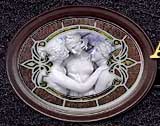|
Literary Commentary: Tracing the Concept of Art through Goldsmith's "The Deserted Village"
The concept of Art can be considered, at least according to the American Heritage Dictionary, as
a "human effort to imitate, supplement, alter, or counteract the work of nature." Some English
literary works themselves fall into this category, especially by way of writing styles and choices
of wording, but the actual contents of the works can also allow the reader a glimpse into what
might have been an author's, and therefore possibly his culture's, attitude toward Art. In
examining various works of early English Literature, it can be difficult to find commentary upon
manmade beauty; rather, authors and poets appear to take more joy in natural occurrences, in
physical appearance, or in chaos.
In more martially minded works, the notion of Art appears concerned more with the brightness of
weaponry and armor or the glorious appearance of personal artifacts rather than Art made for
contemplative purposes. Descriptions of armbands, armor and hall architecture in the epic poem
Beowulf are examples of this, as well as Spenser's The Faerie Queene ("mightie
armes and silver shielde").
Shakespeare's sonnets refer seldom to the makings of man, but in the art of humanity itself;
phrasings such as "Thou that art the world's fresh ornament" and "Shall I compare thee to a
summer's day?" suggest a comparison with the natural world rather than the artificial. Spenser,
aside from his martial references, also indicates in The Faerie Queene that Nature is a
superior form of Art ("A place picked out by choice of best alive / That natures work by art can
imitate").
Robert Herrick is an excellent example of a poet who takes the attitude that beauty appears in
unintentional chaos. His poems "Delight in Disorder" and "Upon Julia's Clothes" see artful beauty
in the shapes taken by cloth upon the body, or the lack of cloth on that body, rather than
abstract concepts created by man. It is beauty in functionality.
In Oliver Goldsmith's "The Deserted Village," Goldsmith's view of Art appears to be subordinate
to the beauty of nature, and the sincerity of functional manmade objects. Far more appreciation is
granted to brooks and bowers, trees and lawns, and to humble mills and garden paths, than to
artful items made for Art's sake. Cleanliness and austere décor are given attention while a
picture is regarded both "for ornament and use." Perhaps this is due to the period, which was
approaching the Romantic, and therefore more drawn to natural simplicity than to opulence and
phrenic artifice; certainly Goldsmith's poem appears to embrace such "artless art."
For Reference:
William Shakespeare's Sonnet 1
William Shakespeare's Sonnet 18
Robert Herrick's "Delight in Disorder"
Robert Herrick's "Upon Julia's Clothes"
Oliver Goldsmith's "The Deserted Village"
David Elsensohn, May 2005
Return to Essays
|

